
When it comes to composting manure, those farms taking part in this
activity have something in common with the U.S. Marines – they are “the
brave, the few.” But their numbers are growing.
When it comes to composting manure, those farms taking part in this activity have something in common with the U.S. Marines – they are “the brave, the few.” But their numbers are growing.
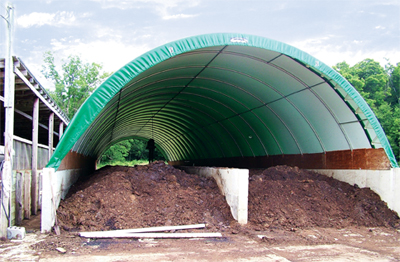 |
|
| Ohio State University is a leader in the United States in compost manufacturing research, and has been for several decades. Submitted photo
|
Research experts warn that having a secure end-market for manure compost is critical to making the effort worthwhile. However, as organic material in soil continues to diminish due to aggressive farming practices, the public continues to demand more organically grown products, farms invest more and more into anaerobic digesters, and industry finds itself under the environmental microscope, there are opportunities out there for some farmers to create an extra income stream with the right approach. The question is where to go for help.
Price Farms Organics, located in Delaware County, Ohio, is one farm heavily invested in a commercial composting operation in addition to raising cattle and hogs. The company produces about 20,000 cubic yards of compost a year, half of which comes from manuare produced from its livestock operations. They also compost bedding from the Columbus Zoo and Aquarium, coffee grounds, horse manure, and even recycled newspapers that the farm first uses for hog barn bedding. About 60 percent of the compost they produce is sold commercially on its own or as a soil mix, and 40 percent is retailed under such names as Barnyard Café and Zoo Brew.
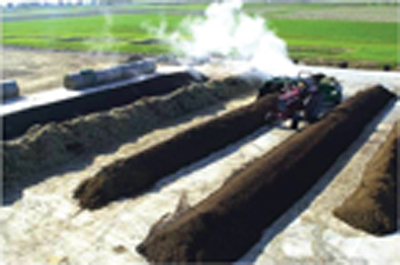 |
|
| Windrows at Ohio State University help to recreate a potential commercial setting for compost production so its acquired knowledge can be transferred to farmers and commercial composters. Submitted photo
|
Owner Tom Price says access to an urban market for the compost is critical to the viability of their composting operation and the up-front capital costs are high, but he is a strong advocate for composting.
“I’d absolutely recommend it,” he says. “Environmentally, it’s a lot sounder practice. Socially, I think it’s a very positive practice with neighbors.”
One confined animal feeding operator to have embraced composting in a big way in Ohio is Daylay Egg Farm, located in West Mansfield. They have installed a German-designed system from Salmet Poultry Systems to biologically process unamended caged layer poultry manure into a composted manure product. The manure comes from about one million chickens managed at the facility. What interested the company in producing compost was the five to six percent nitrogen content in the compost and relatively low 10 to 15 percent moisture content. Daylay Egg Farm discovered that it was economically feasible to market this product within a 50-mile radius of the plant. Upon transport of the manure to the compost building, forced aeration is used through a positive pressure aeration system within the floor to ensure aerobic conditions and high rates of decomposition. Compost is produced by a combination of frequent manure removal, aeration, and routine agitation. It takes about 60 days for the composting process to run its course.
Both Price Farms Organics and Daylay Egg Farm learned a lot from researchers at the Ohio State University Agricultural Research and Development Center (OARDC), a leader in manure composting research in the United States. A lot of the initial focus at the center was to determine why compost in potting mixes was so good at controlling root diseases. Later, the research focus included looking at improving the overall system to reduce the cost of composting and improve the efficiency, by investigating such factors as temperature, moisture content, mixing, frequency, windrow size and the carbon/nitrogen ratio.
“The capital costs initially are a bit of a deterrent because you need a pad and you need some turning equipment,” says OARDC researcher Dr. Fred Michel.
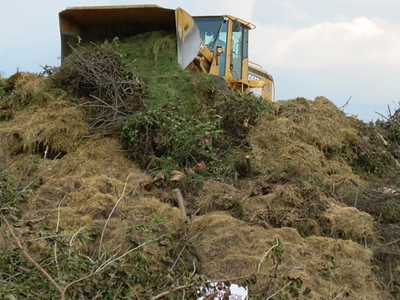 |
|
| It’s hard to believe that within a matter of months, this compost heap at Price Farms Organics will convert into a stable soil amendment. Submitted photo
|
The cost of a concrete pad has been estimated at about $125,000 to $140,000 per acre. Price Farms Organics started with two acres and is now up to about 5.5 acres. However, Price says it was worth it because it has helped them produce consistently high quality compost and the pad is much more resilient to heavy loaders moving material as compared to an asphalt pad or crushed stone.
“One of the things that you need to consider if you are thinking about composting is the end market for the compost,” says Dr. Michel. “If the compost is going to be used on your own farm as a fertility source, it may not make a lot of sense versus liquid manure. So you really need to have a higher value market that you can access with the compost and it needs to be nearby.”
He estimates that the market should be no farther than about 50 miles from the compost production location, if it is being marketed strictly as a nutrient source. Price agrees that having a strong local market is a major advantage for them, being as they are only about 15 miles from the state capital of Columbus.
“We are in such a heavily urbanized area that we’ve got an advantage on some rural operations,” says Price. “We can go into the retail market and, in this day and age, there is much more interest in being green and recycling.”
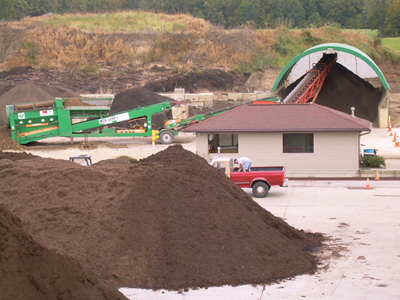 |
|
| Price Farms Organics composts all of its cattle and hog manure, using some on its pastures and selling the rest commercially or through its retail operations. Submitted photo
|
There are some on-farm uses where compost makes a lot of sense. One is as fertilizer in organic farming where pathogen control is an issue, another is as animal bedding on dairy farms, and a third is in situations of intensive grazing pasture management.
In terms of usage in organic farming, Dr. Michel says growers are limited to using liquid manure and compost as fertility sources, and there are restrictions on when the liquid manure can be applied in relation to crop harvest.
“In that situation where it is important to have control of the pathogens, I think we see some farmers going to compost to address that market,” Dr. Michel says. With compost, organic farmers also have more flexibility, as they have the option of applying it closer to harvest due to its non-pathogenic nature and stability.
Price Farms Organics adopted composting of all their cattle and hog manure because it was the right choice for their intensive grazing pasture management system, where cattle are rotated frequently from one pasture to another.
“You can’t put fresh manure on with that kind of system,” says Price. “You can put composted manure on the grass and into the paddocks.” In as short a span as three to four weeks, cattle could be back in an area grazing where compost has been applied.
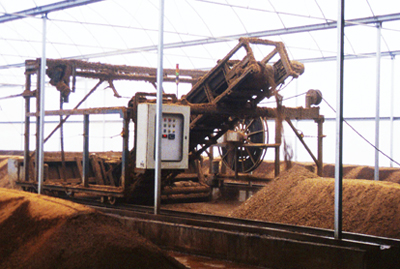 |
|
| Daylay Egg Farm has installed a German-made composting system that allows the company to manufacture compost that contains high nitrogen content. Submitted photo
|
“So, it’s what got us started in composting of manure really,” he says. “We wanted to fertilize our pastures with manure instead of buying fertilizer. I think it’s just as comparable as commercial fertilizer, but more economical.”
Business took off from there to the point where Price Farms Organics now has a significant additional income stream from its well-established compost operation.
In terms of its use on dairy farms, Dr. Harold Keener, OSU researcher and associate chair of the Food, Agricultural and Biological Engineering Department, says recycling of manure into compost for use as bedding in dairy operations, “is a very viable use. It saves them tremendously in their bedding costs and it does work well.”
He adds, however, that based on the feedback he has received from dairy farmers, it is important to control the waste buildup in the bedding compost used in the free stalls. What he has noticed is that successful dairy farms have been able to minimize problems with milk quality by raking wet soil material out of the free stall compost and mechanically stirring bedding by using some type of rake system attached to a skid steer, usually while the cows are in the milking parlour.
While use of compost instead of sand for bedding does not appear to be as forgiving in terms of maintaining milk quality, dairy farmers are able to avoid many of the headaches associated with sand. He’s visited large dairy farms with as many as 3,000 cows that are using compost bedding very successfully.
There is also a trend toward anaerobic digestion on many intensive livestock operations, says Dr. Keener, that provides dairy farmers not only with cost savings in bedding, as solid compost is one of the byproducts of this process, but also a methane gas stream that can then be used to generate power.
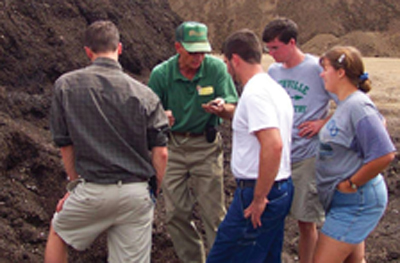 |
|
| Ohio State University researcher, Dr. Harold Keener, discusses the attributes of compost with students. Submitted photo
|
The OARDC has also received a lot of interest in composting of horse manure, as the wood chips often used as bedding for horses in stables or racetracks is also an excellent feedstock for advancing the composting process.
In terms of markets for farm compost, landscapers, market gardens, nurseries and organic farmers are not the only potential places to find customers. Other opportunities are out there depending on where farmers call home. For example, compost is finding use as a soil amendment in situations where industrial activity has a negative impact on soil quality, such as in the oil and gas industry where heavy equipment moving across farm fields to well sites frequently compacts the soil. One Alberta company – Paragon Soil and Environmental Consulting – is conducting trials related to injection of compost pellets to rehabilitate compacted soils. When left alone, experts estimate that it takes damaged soils anywhere from 30 to 50 years to become fully productive again, but initial research conducted by Paragon shows that injection of compost pellets can rehabilitate the soil in just five years. With thousands of oil and gas well sites throughout North America often located on farmland, this represents just one huge opportunity for compost as a soil amendment. Compost could be used to rehabilitate soil in any situation where an industrial activity has a negative impact on soil productivity.